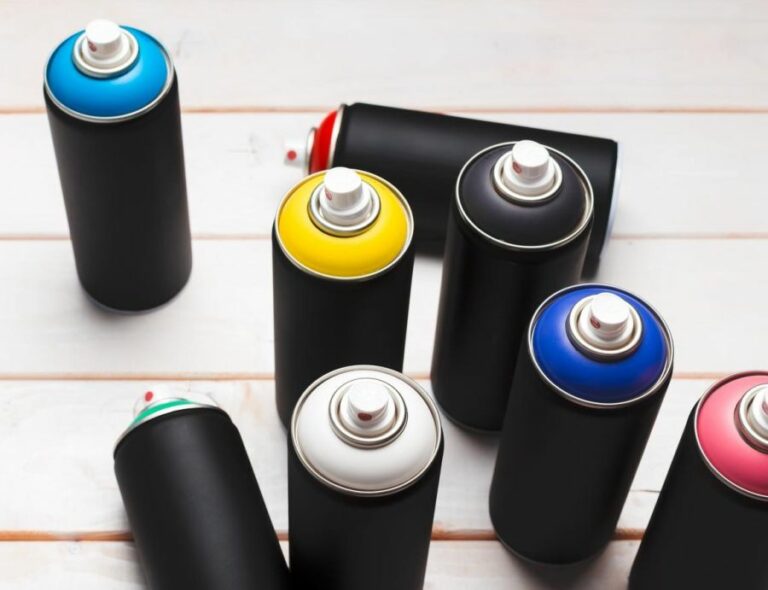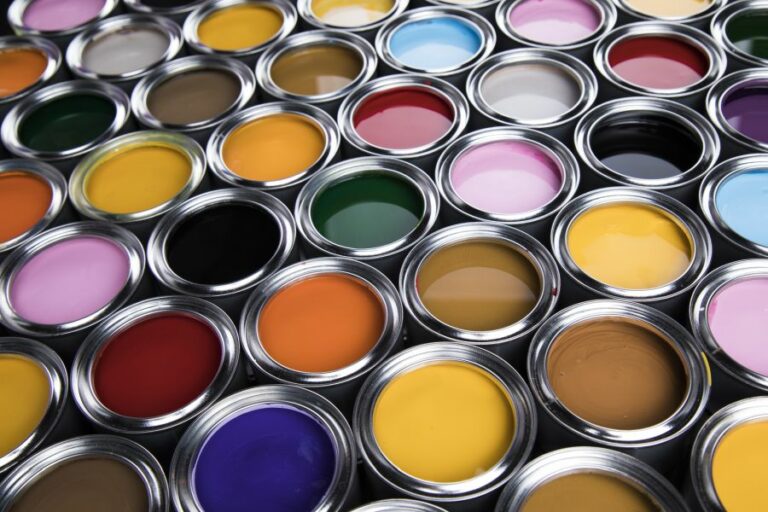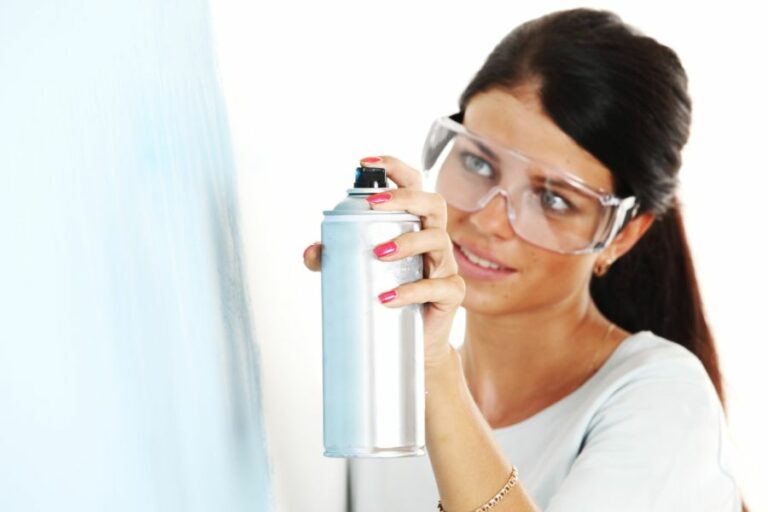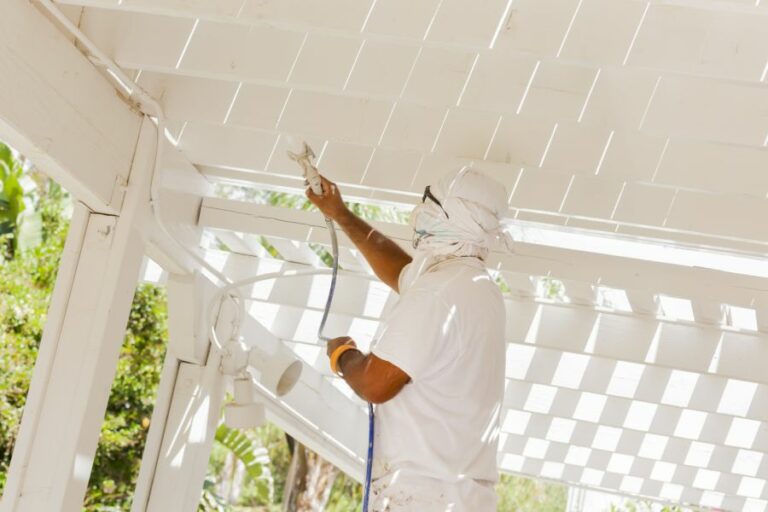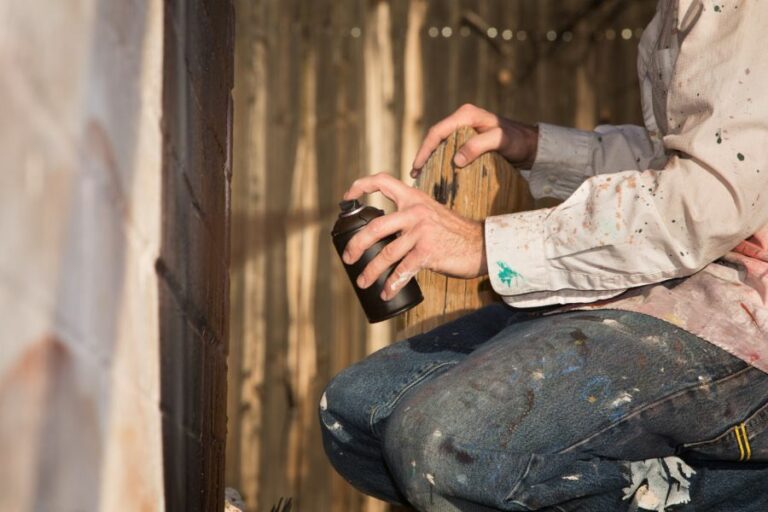Transforming Plastic Surfaces With Spray Paint. What Pros Say
Are you tired of looking at the mundane plastic surfaces around your home and longing to give them a fresh, new appearance? Look no further because spray paint can completely transform those lackluster surfaces into eye-catching pieces of art. I am here to provide you with the knowledge and confidence you need to make your plastic surfaces shine with vibrant colors and textures.
Transforming plastic surfaces with spray paint:
To transform a plastic surface using spray paint, choose a paint specifically formulated for plastic, such as Krylon Fusion or Rust-Oleum Specialty Plastic Primer. Clean the surface, lightly sand if glossy or slick, and mask off areas not to be painted. In a well-ventilated area, apply primer and paint in light, even coats, allowing each layer to dry. Finish with a clear coat, if desired, and follow post-painting care guidelines to maintain the result.

Discover the magic of transforming dull plastic surfaces into vibrant, eye-catching masterpieces with spray paint! Unleash your creativity and explore the endless possibilities of colors and textures. Read on as we guide you through the process, tips, and tricks to achieve stunning results.
Contents
- 1 Revamping Plastic Surfaces Using Spray Paint
- 2 Spray Paint Effectiveness on Plastic Surfaces
- 3 Ensuring Spray Paint Longevity on Plastic Items
- 4 Achieving Spray Paint Adhesion to Plastic Materials
- 5 Preparing Plastic Surfaces for Spray Painting Success
Revamping Plastic Surfaces Using Spray Paint
• Choosing the Right Spray Paint
To achieve the best results when transforming a plastic surface with spray paint, it’s crucial to select the appropriate type of paint. As a general rule, paint formulated explicitly for plastic surfaces tends to yield superior results.
These paints have excellent adhesion, which is critical for preventing peeling or flaking over time. Examples of such paints include Krylon Fusion for Plastic and Rust-Oleum Specialty Plastic Primer.
Before purchasing the spray paint, be sure to read the label for any specific instructions or warnings. This will ensure that you are using a paint suitable for your project.
The Environmental Protection Agency provides useful information on recycling plastics and their recycling codes. Understanding these codes can help you determine which spray paint products work best with your chosen plastic surface.
• Prepping the Surface
A clean and well-prepared surface is essential to achieve a professional-looking finish.
- Clean the surface: Start by cleaning the plastic surface thoroughly. Use a mild detergent, warm water, and a non-abrasive cloth or sponge to remove any dirt, grease, or grime. Rinse well with clean water and allow the surface to dry completely. Avoid using any solvents, as they may damage the plastic.
- Lightly Sand: If the plastic surface is glossy or slick, lightly sand it with fine-grit sandpaper or a sanding sponge to create some texture. This step will increase the paint’s adhesion to the surface. Wipe off any dust with a slightly damp cloth or tack cloth before moving on.
- Mask Off: For a neat finish, protect any areas you don’t want to paint by masking them off with painter’s tape. Apply the tape firmly to avoid any paint seeping underneath.
• Optimal Application Techniques
Spray painting can be messy and overwhelming for beginners, but with the right technique, you can achieve a polished, even finish.
- Set Up: Spray paint can drift, so it’s best to set up your workspace outdoors or in a well-ventilated area. Keep a drop cloth or newspaper nearby to protect the surrounding areas from overspray.
- Prime: Apply a primer designed for plastic surfaces if required. This will provide a better base for the paint to adhere to and ensure the best coverage of your chosen color. Apply the primer in light, even coats, and allow it to dry thoroughly.
- Apply Paint: Shake the spray can for the recommended amount before use. Hold the can approximately 8-12 inches away from the surface and apply light, even coats using a sweeping motion. It’s better to apply multiple thin layers than one thick layer, as this reduces the risk of drips and uneven coverage. Allow each layer to dry before applying the next.
- Finishing Touches: Once you’re satisfied with the coverage, apply a clear coat, if desired, to protect the paint’s finish and increase its durability. Remove any painter’s tape once the clear coat is dry to avoid peeling paint away with the tape.
• Post-Painting Care
Caring for your newly painted plastic surface will enhance its longevity and appearance. Some guidelines to follow include the following:
- Cure Time: Allow the paint to cure fully before reassembling or using the item. Curing times can vary between different spray paint products, so check the label for specific information.
- Cleaning: Clean the painted surface with a non-abrasive cloth and mild detergent. Avoid using any harsh chemicals or scrubbing actions, as this can damage the paint.
- Storage: Store the item in a cool, dry place away from direct sunlight to prevent excessive wear or damage to the paint. Extreme temperature fluctuations can also affect the paint’s durability.
• Tips and Tricks
- It’s essential to maintain a consistent distance between the spray can and the plastic surface during painting. This step ensures even coverage and reduces the risk of drips.
- Practice your spraying technique on a piece of scrap material before working on your main project. This simple step will give you a feel for the can’s pressure and spray pattern.
- Always follow the manufacturer’s directions for each product, as application methods and drying times can vary.
By following these guidelines, you can successfully transform any plastic surface using spray paint. With patience and practice, you’ll achieve a professional, long-lasting result that adds color and character to your project.
Spray Paint Effectiveness on Plastic Surfaces
One of the most common questions asked by DIY enthusiasts and crafters alike is whether spray paint is effective on plastic surfaces. The short answer is yes, but ensuring a smooth, long-lasting finish requires a few preparation steps and the use of the appropriate materials.
• Choosing the Right Spray Paint for Plastic
A crucial factor in achieving the desired outcome when spray painting plastic is selecting the appropriate spray paint. Particularly look for paints specifically formulated for use on plastics. These paints are designed to bond more effectively, ensuring the adhesion of paint to the plastic surface.
Popular brands such as Krylon, Rust-Oleum, and Valspar offer spray paint products formulated for use on plastics. Their products ensure less chipping, peeling, and flaking. You can find these paints in most local hardware stores.
Another option for painting plastic surfaces is using acrylic enamel spray paint, which is also known to bond well with plastic. However, it might still be a good idea to check if the product you choose is recommended for use on plastic.
• Preparing the Plastic Surface for Spray Painting
When spraying paint on any surface, including plastic, preparation is key to achieving a professional-looking finish. Here are several essential steps to follow before painting your plastic surface:
1. Cleaning the Surface
Before painting, always thoroughly clean the plastic surface. Any dirt, dust, or grease on the surface can interfere with paint adhesion and result in an uneven finish. Use a mild detergent mixed with warm water and a soft cloth to clean the surface.
You may also use rubbing alcohol to remove oil or grease.
2. Sanding the Surface
Sanding the plastic surface helps remove any glossy layer and improves paint adhesion. Using a fine-grit sandpaper (preferably 220 to 400 grit), lightly sand the surface in a circular motion. Be sure not to sand too aggressively, as this could damage the plastic.
3. Rinsing and Drying
After sanding, rinse the plastic surface to remove any dust or debris created by the sanding process. Allow the surface to dry completely before proceeding to the next steps.
• Applying the Spray Paint on Plastic Surface
Now that you have chosen the right paint and prepared the surface, it is time to apply the spray paint. The following steps will help you achieve a smooth and even finish:
1. Primer Application
Applying a primer specifically designed for plastic surfaces will improve paint adhesion and prolong the life of the spray paint. Primers also fill in any small scratches or imperfections on the plastic, resulting in a smoother final finish.
Apply one or two light coats of primer, allowing each coat to dry according to the manufacturer’s instructions.
2. Spray Painting Techniques
When using spray paint, there are a few techniques to ensure an even and smooth finish:
- Shake the spray can well before and between applications.
- Hold the spray can 8 to 12 inches away from the surface.
- Use a sweeping motion to apply the paint, overlapping each pass by about 50%.
- Apply multiple thin coats, allowing each coat to dry between applications.
3. Applying a Protective Clear Coat
To seal and protect your freshly painted plastic surface, apply a clear coat designed specifically for plastic surfaces. This will protect the paint from scratches, UV damage, and other environmental elements that can reduce the life of the paint. Allow the clear coat to dry according to the manufacturer’s instructions.
• Final Thoughts
In conclusion, spray paint can indeed work on plastic surfaces when using the proper materials and techniques. By selecting the right spray paint, thoroughly preparing the surface, and applying the paint correctly, you can achieve a professional finish on your plastic projects.
It is important to be patient and take your time when spray painting any surface, as rushing the process can lead to lower-quality results. Happy painting!
Ensuring Spray Paint Longevity on Plastic Items
• Choosing the Right Spray Paint
To achieve a long-lasting, durable finish when spray painting on plastic surfaces, it’s essential to use spray paint specifically formulated for plastics. Regular spray paint may not adhere well or last long on plastic, leading to flaking, peeling, or uneven coverage.
Look for paint products labeled as “spray paint for plastic” or “plastic paint.” Brands like Rust-Oleum, Krylon, and Montana offer suitable options.
• Preparing the Plastic Surface
– Cleaning the Surface
Before applying spray paint to a plastic surface, thoroughly clean it to remove dirt, dust, and oils that can inhibit paint adhesion. Use a mild detergent mixed with warm water and a soft sponge or cloth to scrub the surface, being careful not to scratch it. Rinse the plastic thoroughly and allow it to dry completely.
– Sanding the Surface
Lightly sand the plastic surface to create a rougher texture that will improve the adhesion of the spray paint. This step is particularly crucial if the plastic has a glossy finish. Use fine-grit sandpaper, between 220 to 400 grit, to lightly sand the surface.
Make sure to sand evenly and avoid scratching the surface. Wipe away any sanding dust with a clean cloth before spray painting.
• Applying a Primer
Using a primer specifically designed for plastics will help create a permanent bond between the spray paint and the plastic surface. Primer also helps provide a consistent, smooth finish for the paint and may prevent the plastic’s original color from showing through.
Apply a thin, even coat of primer according to the manufacturer’s instructions. Ensure that you use proper ventilation and protective gear like gloves and masks while applying the primer. Allow the primer to dry fully, as recommended by the manufacturer.
Some primers may require light sanding after they have dried, so follow the product’s recommendations.
• Spray Painting the Plastic
Shake the can of spray paint as recommended by the manufacturer, ensuring that the paint is mixed thoroughly. Hold the spray paint can roughly 12 inches away from the plastic surface, and apply the paint using a continuous, sweeping motion to avoid drips and uneven coverage. Apply multiple thin coats of paint instead of one heavy coat, as this will help to ensure a smoother, more permanent finish. Allow the paint to dry for the recommended time between coats, which can often be found on the product’s label.
• Adding a Clear Topcoat
Applying a clear topcoat, also known as a sealer, will further protect the paint and help make it more permanent on plastic. Choose a topcoat that is compatible with the type of spray paint you used, as well as suitable for plastic surfaces.
Apply the clear topcoat using the same technique as when applying the spray paint. Use thin coats and maintain a consistent distance from the surface. Allow the topcoat to dry for the recommended time before handling or using the plastic item.
• Expert Tips for Making Spray Paint Permanent on Plastic
By following these steps, using the appropriate materials, and taking the necessary precautions, you can make spray paint adhere permanently to plastic surfaces and achieve a professional, long-lasting finish.
| How do you make spray paint permanent on plastic? | |
|---|---|
| 1. Clean the surface | Ensure the plastic surface is clean by wiping it with a cloth and rubbing alcohol or soap and water to remove dirt and grease. |
| 2. Sand the plastic | Lightly sand the surface with fine-grit sandpaper to improve paint adhesion and remove any glossy finish. |
| 3. Apply a plastic primer | Apply a quality plastic primer to provide a suitable base for the spray paint to adhere to. Allow it to dry according to the manufacturer’s instructions. |
| 4. Apply the spray paint | Choose a spray paint designed for use on plastic and apply thin, even coats, allowing each coat to dry before adding the next one. Follow the instructions on the paint can for the best results. |
| 5. Seal the paint | Apply a clear, protective sealant specifically designed for plastic to lock in the color and protect the painted surface from scratches, sun exposure, and other damage. |
| 6. Allow to cure | Allow the paint and sealant to fully cure and harden by leaving the plastic object in a well-ventilated area for the recommended time given by the sealant and paint manufacturers. |
Achieving Spray Paint Adhesion to Plastic Materials
Plastic materials, while versatile and affordable, can be tricky to work with when it comes to painting. If you’ve ever attempted to spray paint plastic, you might have experienced frustration with the paint not adhering properly or even peeling off soon after application.
Thankfully, with the right techniques and materials, it is possible to achieve a professional-looking result when spray painting plastic.
• Choose the Right Paint for Plastic
When it comes to spray painting plastic, it’s crucial to choose the right type of paint that is specifically formulated for use on plastics. Regular spray paint might not adhere properly to plastic surfaces, resulting in a patchy or peeling finish.
Look for spray paint that is labeled as being specifically designed for use on plastics or multi-surface paints that list plastic among the suitable surfaces. These paints typically contain a primer and an adhesive that helps the paint adhere to the plastic surface.
One reputable brand to consider is Krylon FUSION ALL-IN-ONE, as it is specifically designed for plastic and provides excellent adhesion and durability.
• Clean and Prepare the Surface
Before applying any paint to the plastic, it is essential to properly clean and prepare the surface to ensure optimal adhesion. Follow these steps for effective surface preparation:
– Cleaning the Plastic
Remove any dirt, grease, or grime on the surface of the plastic by thoroughly washing it with warm water and dish soap. You can use a soft sponge or cloth to gently scrub the surface. Rinse the plastic thoroughly to remove any soap residue, as any remaining soap could interfere with the paint’s adhesion.
– Drying the Plastic
Once the plastic is clean, make sure it is completely dry before proceeding. You can use a clean, lint-free cloth to pat the surface dry, and then let it air dry for at least 30 minutes to ensure there is no residual moisture.
– Sanding the Plastic (Optional)
Sanding the surface of the plastic can help to create a better surface for the paint to adhere to. However, this step is optional, as many plastic-specific spray paints include an adhesive that can adhere well without the need for sanding.
If you choose to sand the surface, use fine-grit sandpaper (such as 400-grit) and sand the plastic with light, even strokes. Be careful not to apply too much pressure, as this could damage the plastic. Wipe the surface with a clean cloth to remove any sanding dust.
• Applying the Spray Paint
Now that the surface is clean and prepared, it’s time to apply the spray paint.
– Shake the Can Well
To achieve consistent results, be sure to shake the spray paint can vigorously for about 1-2 minutes before using it. This will help ensure that the paint is properly mixed, reducing the risk of blotchy or uneven coverage.
– Test the Spray Paint
Before spraying the plastic, test the paint on a piece of scrap material or cardboard to get a feel for its coverage and consistency. This will allow you to practice your spraying technique and ensure that the paint is coming out smoothly.
– Maintain Proper Distance
When spraying the plastic, hold the can about 8-12 inches away from the surface. This distance will help prevent drips and overspray while ensuring a smooth, consistent coat.
– Apply Thin, Even Coats
To achieve the best results, apply thin, even coats of paint. Start by spraying a light, sweeping coat and allow it to dry for the recommended time on the paint can label (usually around 10-15 minutes).
Once the first coat is dry, apply additional coats as needed, ensuring each layer is dry before adding another. Applying multiple thin coats will result in a more professional-looking finish than one heavy coat.
– Allow the Paint to Dry
After applying the final coat of paint, allow it to dry completely before handling or reassembling the plastic items. The drying time will vary depending on the brand and type of paint used. Refer to the manufacturer’s instructions for specific drying times.
• Tips for Successful Spray Painting on Plastic
Here are some additional tips to help achieve success when spray painting plastic:
- Always spray paint in a well-ventilated area, preferably outdoors or in a garage with open doors and windows.
- Use a drop cloth or newspaper to protect surrounding surfaces from paint overspray.
- Wear gloves, a mask, and eye protection when spray painting to protect your skin, lungs, and eyes.
- If you encounter any drips or runs in the paint, wait until it dries completely before attempting to correct the issue with sandpaper or additional paint.
By following these steps and tips, you can successfully get spray paint to stick to plastic and achieve a professional-looking result.
Step | Instructions |
|---|---|
1 | Clean the plastic surface with soap and water to remove any dirt or debris. |
2 | After the plastic surface is completely dry, use fine-grit sandpaper (between 400-600 grit) to lightly sand the surface for better paint adhesion. |
3 | Wipe down the surface with a microfiber cloth or tack cloth to remove any dust created by sanding. |
4 | Apply a plastic primer specifically designed for bonding paint to plastic surfaces. Follow the manufacturer’s instructions for the best results. |
5 | After the primer has dried according to the manufacturer’s recommended time, apply a spray paint specifically formulated for use on plastic. Apply the paint in thin, even coats, allowing each coat to dry before applying the next. |
6 | After the final coat of paint has dried, you may choose to apply a clear coat sealer to protect your paint job and increase its durability. |
Preparing Plastic Surfaces for Spray Painting Success
Spray painting plastic has become increasingly popular because it is a quick, affordable, and relatively simple process that can yield impressive results. However, many people wonder if prepping the plastic surface is necessary before spray painting.
The answer is a resounding yes. Proper preparation is key to achieving an even and long-lasting finish.
• Importance of Prepping Plastic
Preparing the plastic surface is crucial for several reasons. First, it ensures optimal paint adhesion, which ultimately leads to a longer-lasting and more durable finish. Secondly, it helps eliminate contaminants and impurities on the surface, providing a smooth and clean canvas for the paint application.
Finally, it allows for even paint distribution, preventing uneven coverage, streaks, and blotches that may occur when spraying directly onto an unprepared surface.
• Cleaning the Plastic Surface
Begin by thoroughly cleaning the surface to remove any dirt, grease, or oils that may hinder proper paint adhesion. Use a mild dish soap diluted in water to prevent potential damage to the plastic, and clean the item with a soft cloth or sponge.
Rinse well with clean water, then allow the item to air dry, or use a lint-free cloth to gently pat it dry.
• Sanding the Surface
Sanding the plastic surface is an essential step because it increases surface area, allowing the paint to adhere more effectively. Begin by using 220-grit sandpaper, working in a circular motion, and applying even pressure.
This will create a rough, slightly textured surface that will better accept the paint. After sanding, be sure to remove any residual sanding dust with a microfiber cloth or a tack cloth.
• Using a Plastic Adhesion Promoter
After sanding and cleaning the surface, it’s time to apply a coat of plastic adhesion promoter to further improve paint adhesion. It is especially beneficial for hard-to-paint plastics or those with a slick finish.
Apply the adhesion promoter according to the manufacturer’s instructions, usually in a thin, even coat, and allow it to dry before proceeding to the next step.
• Applying a Primer
Primer serves as an intermediary between the plastic surface and the paint, helping to create a strong bond between the two. Opt for a primer specifically designed for plastics, as it will have the correct formulation to adhere well and provide a stable base for the paint.
Follow the manufacturer’s instructions for application, and allow the primer to dry for the recommended time before moving on to paint application.
• Spray Painting
Now that the plastic is adequately prepped, it’s time to apply the spray paint. To ensure a smooth and even finish, hold the can about 10-12 inches away from the surface and spray using a back-and-forth motion, slightly overlapping each pass.
Apply multiple light coats rather than one heavy coat, allowing each layer to dry according to the manufacturer’s instructions before applying the next one.
• Sealing the Paint
Once the paint is dry, it’s essential to protect the finish by applying a clear sealer. A sealer provides a barrier against damage, fading, and scratching, keeping the paint looking fresh and vibrant for a longer time. Choose a sealer also designed for plastics, and follow the manufacturer’s instructions for the proper application technique and drying time.
• Final Thoughts
Prepping plastic surfaces before spray painting is indeed necessary, as it ensures optimal paint adhesion, a smoother finish, and increased longevity of the final result.
By following these straightforward steps, you can enjoy the impressive results that come from proper preparation and create a professional-looking finish on your plastic items.

